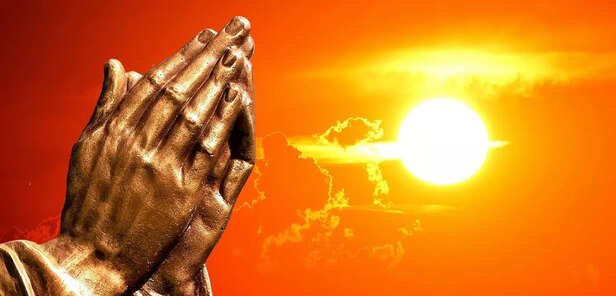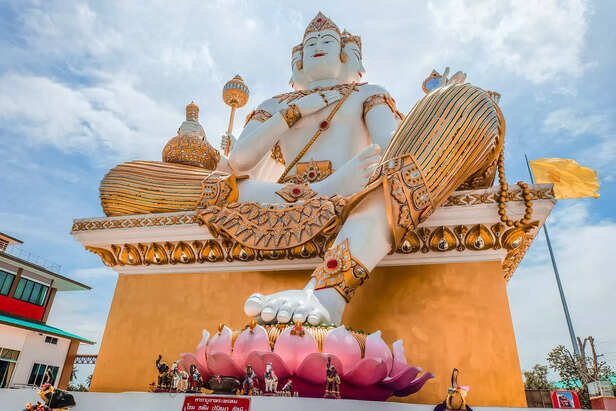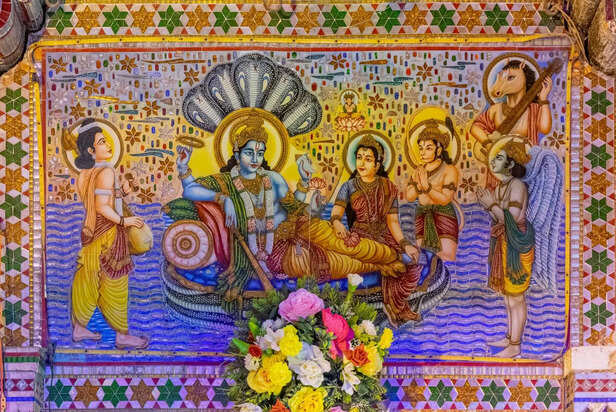Why Vishnu’s Feet Are Worshipped, Even by Brahma
Riya Kumari | Aug 01, 2025, 17:22 IST
( Image credit : Times Life Bureau )
In Hinduism, the concept of touching someone’s feet is not just cultural, it is spiritual. It recognizes where knowledge flows from, where grace descends from, and where surrender begins. But among all the feet ever bowed to, none hold more reverence than the feet of Lord Vishnu, Padmanabha, the one whose very name means “the One with the lotus emerging from His navel”, upon which sits Brahma himself.
We’re taught not to bow before anyone. That dignity means standing tall, unbent. But in the deepest layers of Hindu thought, bowing, not to man, but to truth, is not weakness. It is awakening. And so, even Brahma, the creator of the universe, bows. Not to a throne. Not to a sword. But to the feet of Vishnu. Why? Because the feet represent something most people overlook, the very foundation of all that holds us up.
The Feet That Lie Beneath All Creation

In the Vedas, especially the Purusha Suktam of the Rig Veda, the universe is described as emerging from a cosmic being, Purusha. From His mind came the Moon. From His breath, the Wind. From His head, the sky. But from His feet, came the Earth. That which we walk on. That which bears us all. That which supports even the proudest life without complaint. Feet are the foundation and in Vishnu, they are not the lowest part, but the most accessible part of the divine. The part that willingly comes down to us.
In the Vishnu Purana, it is said that when Vishnu measured the three worlds in His Vamana avatar, His first step covered the heavens, His second the earth and His foot went so high it touched the very edge of the universe. Bali, the asura king, bowed and offered his head to place the Lord’s foot upon it. In this moment, Vishnu’s feet did something no weapon could: they crushed ego, not through violence, but grace.
Brahma Washing Vishnu’s Feet: The Story Behind the Ganga

When Vamana’s foot pierced the universe and rose beyond all realms, it entered Satya Loka, the abode of Brahma. Realizing the divine foot was now in his world, Brahma didn’t hesitate. He washed it with the waters of his kamandalu. The story says that this holy water flowed down to become the Ganga, sacred not because it’s a river, but because it once touched the foot of Vishnu.
Even Brahma, the creator of the Vedas, bowed. Not to a concept, but to the embodiment of balance, compassion, and divine order, Vishnu. Because in that moment, he wasn’t just worshipping a god, he was acknowledging a principle greater than creation: the preserver of dharma.
Why Feet?

Why not the crown, or the heart, or the eyes? Because the feet are where the ego ends. They are the place of surrender. In temples, it is the feet of the deity that devotees reach for, not the crown. Because the crown belongs to the divine, but the feet are where the divine meets you.
Lakshmi, the goddess of wealth and grace, is said to always reside at Vishnu’s feet. Not as a sign of hierarchy, but of eternal service, where love flows not from status, but purpose. In the Bhagavata Purana, it's written:
"Even a drop of water that touches the dust of the feet of Vishnu is enough to cleanse lifetimes of ignorance."
A Lesson for Our Lives

To worship Vishnu’s feet is not an act of humiliation, it is an act of realisation. It reminds us that true greatness isn’t loud, it is grounded. It doesn’t sit above everyone, it supports everyone. Vishnu’s feet walked with the poorest as Rama, ran with the cowherds as Krishna, and still walk silently behind every act of dharma.
Even today, in the lived faith of millions, touching the feet of elders, gurus, or a murti in a temple is an echo of this ancient wisdom. It’s not ritual, it’s recognition. Of what sustains you. Of what you owe your life to. Of what came before you, and what will remain after.
In the Mahabharata, Bhishma tells Yudhishthira,
“The feet of Hari are the only boat to cross the ocean of samsara.”
To bow to Vishnu’s feet is not to look down, it is to look within, to begin where the ego ends, and where grace begins.
The Feet That Lie Beneath All Creation

Lord Vishnu
( Image credit : Times Life Bureau )
In the Vedas, especially the Purusha Suktam of the Rig Veda, the universe is described as emerging from a cosmic being, Purusha. From His mind came the Moon. From His breath, the Wind. From His head, the sky. But from His feet, came the Earth. That which we walk on. That which bears us all. That which supports even the proudest life without complaint. Feet are the foundation and in Vishnu, they are not the lowest part, but the most accessible part of the divine. The part that willingly comes down to us.
In the Vishnu Purana, it is said that when Vishnu measured the three worlds in His Vamana avatar, His first step covered the heavens, His second the earth and His foot went so high it touched the very edge of the universe. Bali, the asura king, bowed and offered his head to place the Lord’s foot upon it. In this moment, Vishnu’s feet did something no weapon could: they crushed ego, not through violence, but grace.
Brahma Washing Vishnu’s Feet: The Story Behind the Ganga

Pray
( Image credit : Pixabay )
When Vamana’s foot pierced the universe and rose beyond all realms, it entered Satya Loka, the abode of Brahma. Realizing the divine foot was now in his world, Brahma didn’t hesitate. He washed it with the waters of his kamandalu. The story says that this holy water flowed down to become the Ganga, sacred not because it’s a river, but because it once touched the foot of Vishnu.
Even Brahma, the creator of the Vedas, bowed. Not to a concept, but to the embodiment of balance, compassion, and divine order, Vishnu. Because in that moment, he wasn’t just worshipping a god, he was acknowledging a principle greater than creation: the preserver of dharma.
Why Feet?

Brahma
( Image credit : Unsplash )
Why not the crown, or the heart, or the eyes? Because the feet are where the ego ends. They are the place of surrender. In temples, it is the feet of the deity that devotees reach for, not the crown. Because the crown belongs to the divine, but the feet are where the divine meets you.
Lakshmi, the goddess of wealth and grace, is said to always reside at Vishnu’s feet. Not as a sign of hierarchy, but of eternal service, where love flows not from status, but purpose. In the Bhagavata Purana, it's written:
"Even a drop of water that touches the dust of the feet of Vishnu is enough to cleanse lifetimes of ignorance."
A Lesson for Our Lives

Lord Vishnu
( Image credit : Pexels )
To worship Vishnu’s feet is not an act of humiliation, it is an act of realisation. It reminds us that true greatness isn’t loud, it is grounded. It doesn’t sit above everyone, it supports everyone. Vishnu’s feet walked with the poorest as Rama, ran with the cowherds as Krishna, and still walk silently behind every act of dharma.
Even today, in the lived faith of millions, touching the feet of elders, gurus, or a murti in a temple is an echo of this ancient wisdom. It’s not ritual, it’s recognition. Of what sustains you. Of what you owe your life to. Of what came before you, and what will remain after.
In the Mahabharata, Bhishma tells Yudhishthira,
“The feet of Hari are the only boat to cross the ocean of samsara.”
To bow to Vishnu’s feet is not to look down, it is to look within, to begin where the ego ends, and where grace begins.
